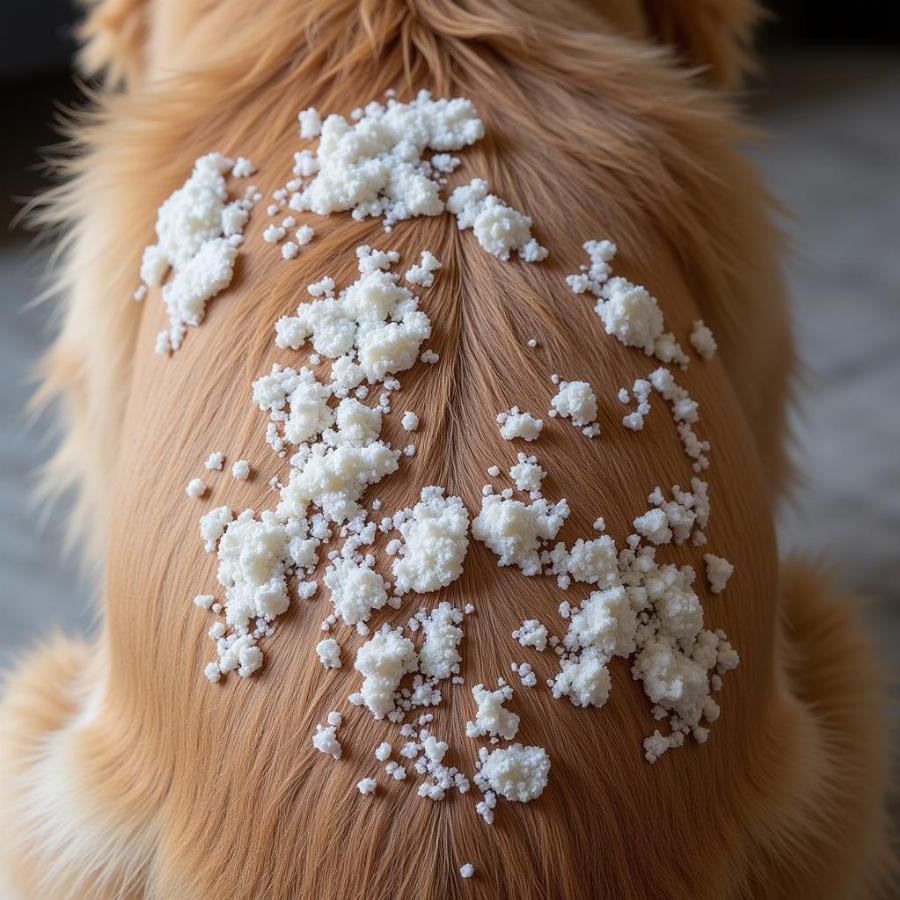Pictures of mange on a dog can be disturbing, but understanding what you’re seeing is crucial for effective treatment. If you’re searching for “pictures of mange on a dog,” you’re likely concerned about your furry friend’s skin health. This article will guide you through identifying different types of mange, understanding their causes, and exploring treatment options. We’ll also discuss preventative measures to keep your canine companion healthy and happy.
Understanding Canine Mange: Types and Symptoms
Canine mange is a skin condition caused by microscopic mites. Different types of mites cause different types of mange, each with its own set of symptoms. Recognizing these symptoms, often aided by pictures of mange on a dog, is the first step towards diagnosis and treatment.
Demodectic Mange (Demodicosis)
Demodectic mange, also known as demodex, is caused by the Demodex canis mite. This mite is naturally present on dogs in small numbers, but an overgrowth can lead to mange. Localized demodectic mange appears as small, patchy hair loss, often on the face, legs, or trunk. Generalized demodectic mange affects larger areas of the body and can cause severe skin inflammation, hair loss, and secondary infections.
Sarcoptic Mange (Scabies)
Sarcoptic mange, commonly known as scabies, is caused by the Sarcoptes scabiei mite. This highly contagious type of mange causes intense itching, hair loss, and crusty skin lesions. The mites burrow into the skin, causing severe irritation. Sarcoptic mange can spread quickly between dogs and even to humans, although the human infestation is usually temporary.
Cheyletiellosis (“Walking Dandruff”)
Cheyletiellosis is caused by the Cheyletiella mite, often referred to as “walking dandruff” due to the appearance of large, white flakes of skin moving across the dog’s coat. These mites are larger than other mange mites and can be seen with the naked eye. While less common than demodectic or sarcoptic mange, cheyletiellosis can still cause itching and skin irritation.
 Cheyletiellosis (Walking Dandruff) on Dog
Cheyletiellosis (Walking Dandruff) on Dog
Diagnosing and Treating Mange
If you suspect your dog has mange, a visit to the veterinarian is essential. The veterinarian will perform a skin scraping to identify the type of mite present. Treatment varies depending on the type of mange:
- Demodectic Mange: Treatment may include medicated dips, shampoos, or oral medications. Generalized demodectic mange requires more aggressive treatment.
- Sarcoptic Mange: Treatment usually involves medicated dips or oral medications. It’s important to treat all dogs in the household, even if they aren’t showing symptoms.
- Cheyletiellosis: Treatment typically involves medicated dips, shampoos, or sprays.
Preventing Mange
While not all types of mange are preventable, some measures can help reduce the risk:
- Regular veterinary checkups
- Maintaining a healthy diet
- Avoiding contact with infected animals
- Promptly addressing any skin issues
Conclusion
Pictures of mange on a dog can be a valuable tool in recognizing potential skin problems. Early diagnosis and treatment are crucial for managing mange and preventing its spread. If you notice any unusual skin changes in your dog, consult your veterinarian immediately.
FAQ
- Is mange contagious to humans? Sarcoptic mange can be temporarily transmitted to humans.
- Can mange be cured? Yes, most cases of mange are treatable.
- How is mange diagnosed? A veterinarian will perform a skin scraping to diagnose mange.
- How can I prevent mange in my dog? Regular vet checkups and a healthy lifestyle can help prevent mange.
- What are the symptoms of mange? Symptoms include itching, hair loss, and skin lesions.
Beaut Dogs is your trusted source for all things canine, offering expert advice and reliable information on dog breeds, care, and health. For personalized guidance on managing canine mange, Email: [email protected] to receive detailed and accurate information from Beaut Dogs. Visit us at https://beautdogs.com for more helpful resources and expert tips.